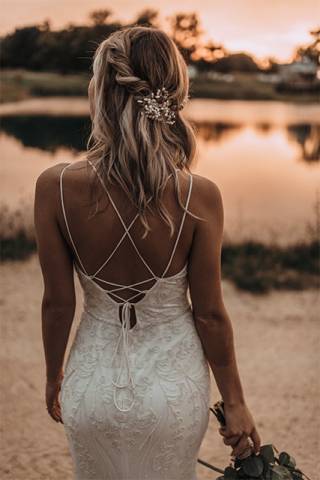Creating the perfect look for you!

image credit Unsplash
GETTING MARRIED?
This is your day to shine and look your very best. So don't be tempted, as many brides are, to look so different that they are hardly recognised as they walk down the aisle! Looking your best is all about bringing out your best features and flattering them, which you will hopefully be able to do with some of the tips and information we have included.
Getting your hair right:
Firstly we would like to thank Jacki Wadeson and Pat Dixon, for permission to use excepts from their book, Bridal Hair, published by Macmillan Press. A fabulous source of information for hairdresser and prospective bride alike, it really should be a must in the salon when discussing bridal hair. As we have discovered in compiling this report there are not too many good collections of bridal hair looks to choose from and this is one of them. The tips below are both our own and edited extracts from the book.
Consultation:
Your Dress Whether it is simple flimsy or full, how this works with your body shape and balances with hair/head-dress.
Neckline Certain necklines work with certain styles or lengths of hair.
Headdress Colour, style/length and weight and how it attaches all need to be discussed.
Fabric colours Hair and skin tones work with certain fabric colours: white, with ash blonde, medium brown or black hair; ivory/oyster, with strawberry, auburn or chestnut hair; gold, with brown chestnut or red; silver with dark blonde, blue-black, ash brown or ash blonde and pastels look best on fair hair.
Timing Day or evening?
Type of Wedding Traditional, modern, medieval or classic theme? Church or civil ceremony?
For your hair to be at its best you should begin a treatment and conditioning program a few months prior to the event. Ask your stylist to recommend the right products for you.
Headdress:
Don't rely on the combs or fixings that are already attached as they are often not suitable or are incorrectly fitted for how the rest of your hair will be worn. Your hairdresser will be able to provide you with alternative clips, pins etc., but she will need time to get them.
The weight of the headdress is of great importance for comfort and it's ability to stay put. For example, if you have fine hair a heavy headdress will not stay in place.
Flowers:
Flowers are a popular alternative to a more formal headdress or in combination with a headdress. They can be secured in the hair by threading the stem through the looped end of a hairpin and then using a grip to keep the pin in place. Tiny braids against the scalp to which the stem is stitched is another option if your hair is fine and does not hold a grip well.
Veils:
Veils work best when the style has some height, hence the popularity of hair-up for a bridal look. A general rule of thumb is that if you have a simple dress then use an elaborate veil. If you have an ornate dress, use a simple veil. You would normally fix them in place over your face and then flip it back. If wearing a tiara as well it should be inserted first.
Veil types include:
Great Tip: To remove creases from a veil, simply hold it taut and use the hot air of a hairdryer to smooth over the surface. Spray starch can also be used with this method but only on modern veils.
Hats:
Whether the design of the hat is plain or swathed in organza, lace or flowers, it needs a neat hairstyle to balance it. Short hair can be styled behind the ears, whilst longer hair is best slicked back and formed into a neat, smooth bun at the nape of the neck.
Beauty Tips:
VirtualHairCare.com is the only place to find out everything you would ever need to know about your hair. From the latest looks and styles and how to maintain them, through to practical stuff like how to get the best out of your next salon visit, what products are best for you and medical conditions of the hair and scalp. For all the latest about hair, check out Virtual HairCare
MORE



